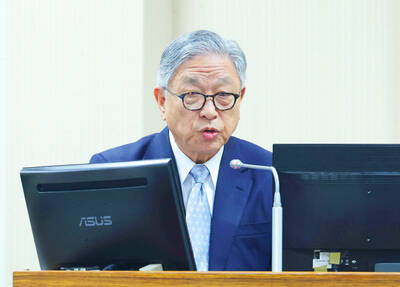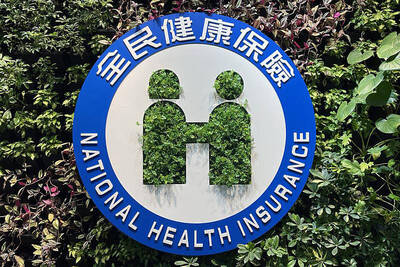The government has staged a joint military-Coast Guard Administration (CGA) protection and rescue exercise in an area where China’s controversial air defense identification zone overlaps with those of Taiwan and Japan in the East China Sea.
The multipurpose drill on Monday last week was seen as an indication that Taiwan is pursuing its own national interests, despite China’s announcement in November last year of a new air defense identification zone that heightened tensions in the region.
The vessels and aircraft involved in the drill moved north toward the nation’s “provisional law enforcement boundary” 270 nautical miles (500km) off the northern tip of Taiwan.
They crossed the air defense identification zones of both China and Japan and moved toward China’s Chunxiao gas field, which is located within the enforcement boundary.
Two coast guard patrol vessels, the Hsin Bei and the Ho-shin, were joined by the navy’s Kang Ding frigate off Keelung and first headed toward Pengchia Islet, about 30 nautical miles away.
Once there, they conducted simulated firings of 20mm and 40mm guns.
They were then joined by an air force S-70C helicopter, which cooperated with the Hsin Bei in a drill simulating the rescue of people from the sea.
As the ships headed further north, they were joined by an S-2T marine patrol aircraft and two F-16 fighter jets, which flew over the Hsin Bei and Kang Ding at an altitude of 152m in an identification and communication drill.
When the vessels and the aircraft reached the northernmost line of the nation’s air defense identification zone, about 133 nautical miles north of Keelung, the Kang Ding and the Feng Yang — another navy frigate — remained to stand guard while the Hsin Bei and the Ho-shin continued north on a patrol mission to protect Taiwanese fishing boats operating nearby.
At 6am the next day, the two coast guard vessels were passing near the Chunxiao gas fields and approaching the 270 nautical mile boundary when they encountered a Japan Coast Guard patrol boat, the 1,000 tonne PL-120 Kurisaki.
There was a tense moment when the crew aboard the Japanese ship tried to observe the Ho-shin at a short distance, and the crew on the Ho-shin did the same to the Kurisaki, bringing the two vessels within 0.5 nautical miles of each other at 6:12am.
However, the Japan Coast Guard patrol boat then sailed off.
At 6:20am, the coast guard ships conducted a series of checks and patrols around wellheads in the Chunxiao gas field, drawing the attention of China’s Hai Yang Shi You 603 tug and supply ship.
The Chinese ship made radio contact with the Hsin Bei, which responded by explaining that the coast guard was carrying out its mission to protect its fishermen.
The Chinese tug did not try to gather information on the Hsin Bei, instead anchoring quite a distance away.
As the Taiwanese vessels began their voyage back to Taiwan on Tuesday last week, Japan sent several SH-60K choppers and P-3C surveillance aircraft to monitor the Hsin Bei and the Ho-shin at low altitude before flying away.
The two coast guard vessels were then escorted home by navy ships that had been on standby, returning to Keelung at 6am on Wednesday last week.

A decision to describe a Chinese Ministry of Foreign Affairs statement on Singapore’s Taiwan policy as “erroneous” was made because the city-state has its own “one China policy” and has not followed Beijing’s “one China principle,” Deputy Minister of Foreign Affairs Tien Chung-kwang (田中光) said yesterday. It has been a longstanding practice for the People’s Republic of China (PRC) to speak on other countries’ behalf concerning Taiwan, Tien said. The latest example was a statement issued by the PRC after a meeting between Singaporean Prime Minister Lawrence Wong (黃循財) and Chinese President Xi Jinping (習近平) on the sidelines of the APEC summit

Taiwan’s passport ranked 34th in the world, with access to 141 visa-free destinations, according to the latest update to the Henley Passport Index released today. The index put together by Henley & Partners ranks 199 passports globally based on the number of destinations holders can access without a visa out of 227, and is updated monthly. The 141 visa-free destinations for Taiwanese passport holders are a slight decrease from last year, when holders had access to 145 destinations. Botswana and Columbia are among the countries that have recently ended visa-free status for Taiwanese after “bowing to pressure from the Chinese government,” the Ministry

HEALTHCARE: Following a 2022 Constitutional Court ruling, Taiwanese traveling overseas for six months would no longer be able to suspend their insurance Measures allowing people to suspend National Health Insurance (NHI) services if they plan to leave the country for six months would be abolished starting Dec. 23, NHIA Director-General Shih Chung-liang (石崇良) said yesterday. The decision followed the Constitutional Court’s ruling in 2022 that the regulation was unconstitutional and that it would invalidate the regulation automatically unless the NHIA amended it to conform with the Constitution. The agency would amend the regulations to remove the articles and sections that allow the suspension of NHI services, and also introduce provisional clauses for those who suspended their NHI services before Dec. 23, Shih said. According to

Minister of Labor Ho Pei-shan (何佩珊) yesterday apologized after the suicide of a civil servant earlier this month and announced that a supervisor accused of workplace bullying would be demoted. On Nov. 4, a 39-year-old information analyst at the Workforce Development Agency’s (WDA) northern branch, which covers greater Taipei and Keelung, as well as Yilan, Lienchiang and Kinmen counties, was found dead in their office. WDA northern branch director Hsieh Yi-jung (謝宜容), who has been accused of involvement in workplace bullying, would be demoted to a nonsupervisory position, Ho told a news conference in Taipei. WDA Director-General Tsai Meng-liang (蔡孟良) said he would